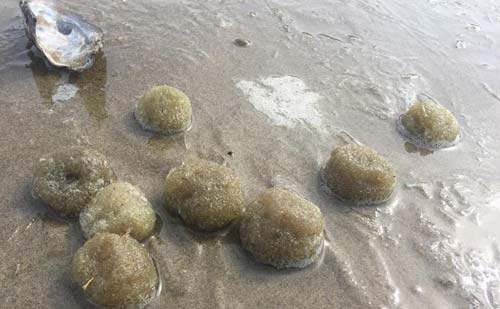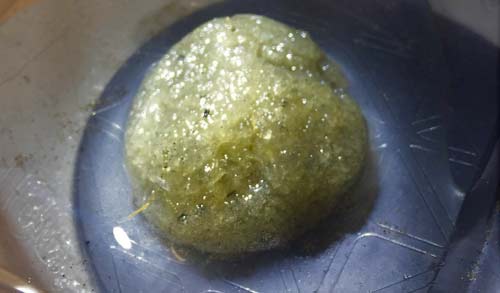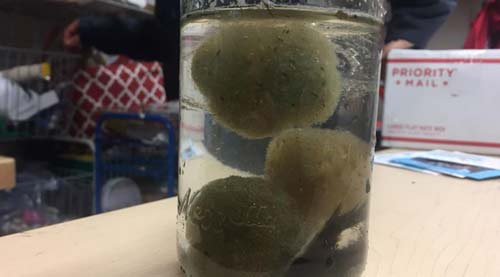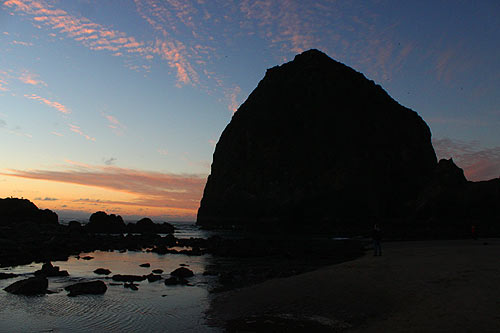Weird, Puzzling Balls of Goo Identified: Oregon Coast, British Columbia
Published 06/06/2018 at 11:22 PM PDT - Updated 06/07/2018 at 3:22 AM PDT
By Oregon Coast Beach Connection Staff

(Cannon Beach, Oregon) – They were weird. They were puzzling. They were kind'a gooey. And for awhile the possible answers were all over the map. Literally, in two distinct ways: with the possible answer and with the locale. These mysterious “beach balls” had been found in British Columbia, Canada and the Oregon coast. (Photos courtesy Haystack Rock Awareness Program).
Includes exclusive listings; some specials in winter
In Cannon Beach:
Includes rentals not listed anywhere else
In Manzanita, Wheeler, Rockaway Beach:
Some specials for winter
In Pacific City, Oceanside:
Some specials for winter
In Lincoln City:
Some specials for winter
In Depoe Bay, Gleneden Beach:
Some specials for winter
In Newport:
Look for some specials
In Waldport
Some specials for winter
In Yachats, Florence
Some specials for winter
It all started with the Haystack Rock Awareness Program (HRAP) in Cannon Beach. They starting noticing little, sort of squishy balls of something showing up in the area. No one there knew what it was; no one had seen it before. Daily investigations of the beach kept yielding samples of the semi-gooey stuff, which they brought back for study, or at least documentation.
HRAP spokesperson (and beach kingpin) Kari Henningsgaard said one of the program’s volunteers discovered it on April 9, and a mystery was born.
“We asked the Seaside Aquarium and Tiffany Boothe guessed it to be a compound tunicate - possibly stubby stalked compound tunicate,” Henningsgaard said. “Fawn Custer of Coast Watch also guessed it was a tunicate. Citizen scientist Stephen Grace thought they were bryozoan colonies, and guessed them to be Pectinatella magnifica. Eric Owen, land steward for the North Coast Land Conservancy, found them to be inconsistent to what he had experienced that species to look like.”
Then, it turns out, biologists in British Columbia had also been puzzling over what became nicknamed “beach balls.” Among them, a marine biologist from southern Canada known as the Marine Detective on Facebook joined in the search, posting her own shots of the round oddities, those from Cannon Beach, and from other locales.
Her real name is Jackie Hildering, and she zoomed into scientific discovery action mode.
“Okay, this one is driving we marine nerds crazy,” Hildering wrote on FB. “What are these ocean balls?! I first noted them in April 2016 in Port McNeill, British Columbia, and this year known documentations include: Haystack Rock Awareness Program in Oregon and Cyndi Browne in Port McNeill.”

Then the answers slowly came. Another biologist in the province had examined them under the microscope and figured out they were likely egg masses from a kind of sea worm called the Pile Worm or the Clam Worm. Technically: a polychaete worm by the real name of Nereis vexillosa. Other marine brains chimed in and confirmed.
So why were these showing up just now along the west coast of the continent?
Hildering doesn’t think that was the case.
“There’s nothing out there in the ocean that was causing them to come in,” she said. “They’ve probably been coming in all along. It’s just now that humans are noticing.”
There’s simply a lot of stuff out there in the ocean, and it’s hard to notice everything that’s coming in with the tides, she said.
The clam worm itself lives just a little ways offshore, probably just beneath the breakers you see coming in. They reproduce by ejecting parts of their bodies, which then eventually fertilize the eggs the females have released into the same area of water (known as a mating swarm.) The fertilized mass drops to the ocean floor and grows to about the size of an egg.
Clam worms are often used for bait and will squirm like crazy when captured. They also pack some powerful jaws for such small creatures and can bite when handled. You needn't worry about them being on bad behavior if you're swimming in the ocean, however.
Mating is done in winter and spring and dependent on darkness. If these egg masses wash up again in the area, it will be next season. Oregon Coast Lodgings for this - Where to eat - Maps - Virtual Tours
Cannon Beach Lodging
Nehalem Bay Lodgings
Manzanita Hotels, Lodging
Three Capes Lodging
Pacific City Hotels, Lodging
Lincoln City Lodging
Depoe Bay Lodging
Newport Lodging
Waldport Lodging
Yachats Lodging
Oregon Coast Vacation Rentals
Oregon Coast Lodging Specials



More About Oregon Coast hotels, lodging.....
More About Oregon Coast Restaurants, Dining.....
LATEST Related Oregon Coast Articles
Likely just before dawn best hour but peak happens during daylight. Weather
Dark Sky Week is Prime Along Oregon Coast: Where and Where Not to Go
General guide to dark sky viewing from south to north coast. Astronomy
Sizable Price Drop, Deals in Lincoln City During Quiet of April on Central Or...
20 perc off at A1 Vacation Rentals across its roster, including Gleneden Beach. Lincoln City specials
Upcoming S. Oregon Coast Events Include Gem Show, History: Coos Bay, Bandon
May 6 talk at Coos History Museum, Mayfly Fest May 17, Bandon Rock / Gem Show June 7,8
Washington Coast Cleanup on April 19 - Coinciding with Oregon Coast's SOLVE E...
From the Puget Sound to Long Beach, alongside Oregon's cleanup. Washington coast events, Seaside events
Astoria's Riverwalk Gets New Lighting, More N. Oregon Coast Roadwork
Delays coming this summer, but the riverwalk has a new look. Seaside, Cannn Beach
April Gets Even Cheaper Midweek at Depoe Bay, Lincoln City: Oregon Coast Deals
Off-season rates plus more at Keystone Vacation Rentals. Depoe Bay lodging specials, Lincoln City hotel reviews, Newport hotel reviews
Washington Coast Begins Week of Clam Digs, April 12 Through 18
Long Beach, Twin Harbors, Mocrocks and Copalis at different times. Washington coast events
Back to Oregon Coast
Contact Advertise on BeachConnection.net
All Content, unless otherwise attributed, copyright BeachConnection.net Unauthorized use or publication is not permitted














































